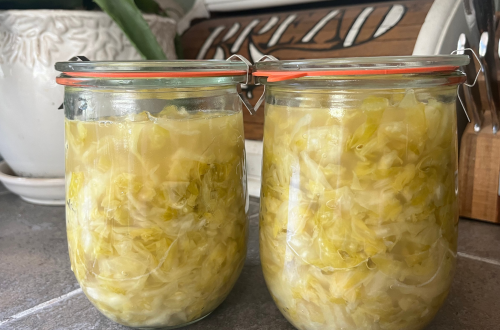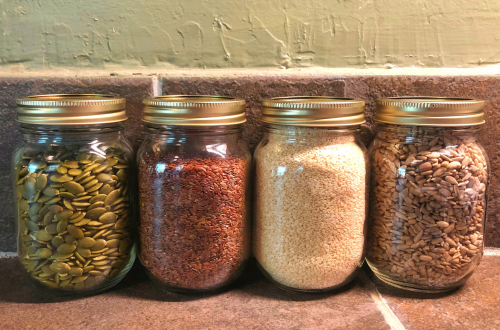I first became serious about trying to reduce the toxins in my home while struggling to become pregnant – I wanted to get rid of anything that could potentially be contributing to the problem. But I was very quickly overwhelmed with just how many things I was going to have to change – and buy – to do so. From plastic kitchen items to personal care products to candles and bedding, the list seemed endless, and I had no clue where to start. So I put together this easy guide to start gradually detoxifying your home while sticking to a budget.
Step 1: Start with items you don’t need to replace.
An easy place to start detoxing your home without spending a dime is to get rid of potentially problematic items that you don’t need to replace, at least not right away. For me, this was my huge collection of candles that, although they smelled lovely, contained fragrances and dyes that I no longer wanted my family or pets exposed to. I left myself a few soy-based candles and can eventually replace some of my collection with non-toxic candles or wax melts.
Other items to consider ditching for this step include air freshening sprays, perfumes and scented lotions, and fake plants, which are made of synthetic plastics and can leach toxins into the air. Down the road, you can decide to replace these items with non-toxic alternatives, but in the meantime, you can get by without spending any money on this step.
Step 2: Replace less-expensive items as you need them.
When you’re ready to start replacing a few items in your home with cleaner options, start with the less-expensive items on your list and only replace those items as you need them. For example, when you are about to run out of laundry detergent, grab a cleaner version instead of your regular buy. This helps to cut down on how much money you have to spend at once, allowing you to gradually replace items as you need them.
Some of the household and personal care items I started with were:
- Laundry detergent: I switched to Molly’s Suds.
- Dryer sheets: I switched to Molly’s Suds.
- Dishwasher pods: I switched to Molly’s Suds.
- Deodorant: I switched to Schmidt’s.
- Hand soap: I switched to Dr. Bronner’s castile soap.
- Body wash: I switched to Native.
As you get more advanced in your home detox and self-sustainable living, you can even try your hand at making some of these household items yourself, such as DIY pine cleaner.
Step 3: Replace moderately expensive items as you need them.
As you’re ready, start tackling moderately expensive items with cleaner options as you need them. These items might include makeup, skincare products, and even food items like mold-free coffee. While non-toxic cosmetics and organic specialty foods can often be more expensive than their problematic counterparts, they don’t have to be. Once you know which are the worst ingredients and additives to avoid, you can shop for items that are much better for you and your family but that still fall within budget.
Some of the worst ingredients to avoid in cosmetics and skincare products include:
- Formaldehyde and its derivatives
- Phthalates
- Parabens
- Polyfluoroalkyl substances (PFAs)
- Mineral oils
- Ethylene Oxide
- Heavy metals like cadmium, chromium, and others
- Silica
Step 4: Replace more expensive items by category.
As your budget allows, pick one type of item that will cost some money to replace and start replacing that little by little. For example, I started with plastic food containers. While not a huge expense, glass containers are a bit of an investment, so I started with a few here and there until I worked my way up to being 100% plastic-free in this area.
Next up might be pots and pans, which can be even more expensive than food containers. You might start by replacing a single non-stick pan with a cleaner option such as stainless steel or cast iron. Gradually build up your new collection as you have the funds for it, so you don’t have to invest in an entirely new stock of pots and pans all at once.
Bedding is another more expensive category you might choose to gradually swap out. I started with an organic bamboo sheet set, as sheets are less expensive than the comforter, though can still be quite an investment.
Step 5: Add new beneficial items.
Detoxing your home isn’t all about removing items – you can add a few helpful items to your home as you have the budget for them, such as air purifiers or water filtration systems. Because these items can be on the expensive side, they can go on your longer-term list.
You can also decide to spend a little money now to end up saving money in the long-run by investing in clean products like reusable paper towels and diapers and even trading tampons for a menstrual cup.
Bottom Line: My Top Tips for Detoxing Your Home
I know firsthand how overwhelming trying to rid your home of toxins can feel. These are my top three tips to keep in mind when getting started:
- Don’t take an all-or-nothing approach. Detoxifying your home isn’t going to happen overnight, and that’s just fine. Start with one simple change and gradually build on that as your budget allows.
- Don’t get too bogged down with product labels. It’s easy to become obsessed with reading product labels and finding fault with just about every product imaginable, including some of the better choices. Unless you make products yourself, it can be difficult or even impossible to find the “perfect product” that checks every single box. It’s okay to choose a much better product than you were using vs. a perfect one.
- Expect some trial and error. When choosing new products, it can take a few tries to find your favorites. Don’t get discouraged if the first one you try isn’t a fit.
What tips do you have for detoxing your home without breaking the bank?






